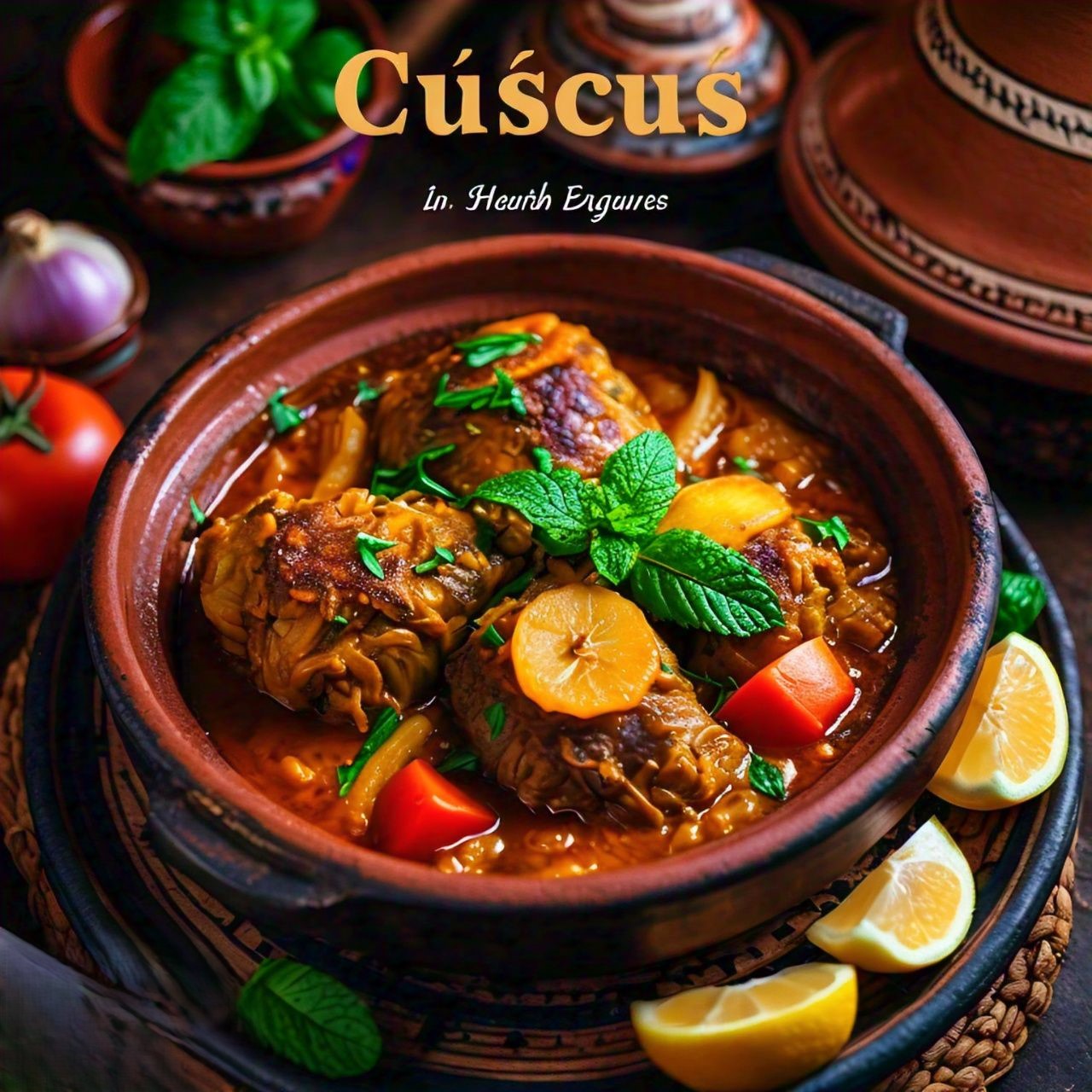Cuşcuş, a staple dish from North Africa, has gained worldwide recognition for its versatility, nutritional value, and delightful taste. This article aims to provide a detailed exploration of cuşcuş, its history, cultural significance, variations, and modern adaptations.
We will delve into its nutritional benefits, cooking techniques, and global influence, offering insights that go beyond the usual information available online. Whether you are a culinary enthusiast or simply curious about this iconic dish, this comprehensive guide will serve as an invaluable resource.
Contents
The Origins of Cuşcuş
Historical Background
Cuşcuş is a traditional dish with roots in North Africa, particularly in countries like Morocco, Algeria, and Tunisia. It is believed to have originated in the Maghreb region during the 11th century. The dish quickly became a staple due to its simplicity, affordability, and ability to feed large groups. Cuşcuş was traditionally made from semolina wheat, which was rolled into tiny granules and steamed over a stew. This method of preparation not only made it a versatile dish but also allowed it to be stored for extended periods, making it a practical choice for nomadic tribes.
Cultural Significance
Cuşcuş holds a special place in North African culture and is often served during important celebrations and gatherings. It is a symbol of hospitality and unity, as families and friends come together to share a communal meal. In many North African households, cuşcuş is prepared every Friday as a part of the traditional family meal. Its cultural significance extends beyond North Africa, as the dish has become popular in various countries around the world, each adding its unique twist to the classic recipe.
Spread Across the Globe
The spread of cuşcuş beyond North Africa can be attributed to several factors, including trade, migration, and globalization. As North African communities settled in different parts of the world, they brought their culinary traditions with them, introducing cuşcuş to new audiences. Over time, cuşcuş has been embraced by diverse cultures and adapted to suit local tastes and ingredients. Today, it is enjoyed in various forms across Europe, the Middle East, and the Americas, highlighting its universal appeal.
The Nutritional Value of Cuşcuş
Health Benefits
Cuşcuş is not only delicious but also packed with essential nutrients that contribute to a balanced diet. Here are some of the health benefits associated with cuşcuş:
- Rich in Carbohydrates: Cuşcuş is an excellent source of carbohydrates, providing the body with energy for daily activities. It is especially beneficial for athletes and individuals with active lifestyles.
- Low in Fat: Compared to other grains and pasta, cuşcuş is relatively low in fat, making it a healthy choice for those looking to maintain a balanced diet.
- High in Fiber: Whole wheat cuşcuş contains a significant amount of dietary fiber, which aids in digestion and helps maintain healthy cholesterol levels.
- Contains Essential Minerals: Cuşcuş is a good source of minerals such as selenium, potassium, and magnesium, which play vital roles in various bodily functions.
Nutritional Comparison with Other Grains
When compared to other grains and pasta, cuşcuş holds its own in terms of nutritional value. Here is a brief comparison:
- Cuşcuş vs. Rice: Cuşcuş has fewer calories and carbohydrates than white rice, making it a lighter option for those watching their calorie intake.
- Cuşcuş vs. Quinoa: While quinoa is higher in protein and fiber, cuşcuş is lower in calories and carbohydrates, making it suitable for different dietary preferences.
- Cuşcuş vs. Pasta: Cuşcuş is often considered a healthier alternative to traditional pasta due to its lower fat content and higher fiber levels.
Varieties of Cuşcuş
Traditional North African Cuşcuş
The traditional preparation of cuşcuş involves steaming semolina granules over a flavorful stew or broth, allowing the grains to absorb the rich flavors of the dish. Common accompaniments include vegetables, meat (such as lamb or chicken), and aromatic spices like saffron, cumin, and coriander. This version of cuşcuş is typically served with a hearty stew poured over the top, creating a satisfying and aromatic meal.
Modern Adaptations
In recent years, cuşcuş has undergone various adaptations to cater to modern tastes and dietary preferences. Some popular variations include:
- Whole Wheat Cuşcuş: Made from whole wheat flour, this version of cuşcuş is higher in fiber and nutrients, appealing to health-conscious individuals.
- Gluten-Free Cuşcuş: For those with gluten sensitivities, gluten-free cuşcuş made from alternative grains like corn or rice is a popular option.
- Flavored Cuşcuş: To add an extra dimension of taste, cuşcuş can be infused with herbs, spices, or even fruit, creating a unique and flavorful dish.
International Interpretations
As cuşcuş has gained popularity worldwide, various countries have put their spin on the dish. Here are a few international interpretations:
- Italian Cuşcuş: In Italy, cuşcuş is often served with seafood, reflecting the country’s coastal influences. It is typically prepared with tomato-based sauces and seasoned with Mediterranean herbs.
- Middle Eastern Cuşcuş: In Middle Eastern cuisine, cuşcuş is commonly served as a side dish or salad, mixed with ingredients like chickpeas, parsley, and lemon.
- American Cuşcuş: In the United States, cuşcuş is often used as a base for salads or as a substitute for rice in various recipes. It is frequently paired with grilled vegetables and proteins for a healthy and satisfying meal.
Cooking Techniques for Perfect Cuşcuş
Traditional Steaming Method
The traditional method of cooking cuşcuş involves steaming the grains over a pot of simmering stew or broth. This technique allows the cuşcuş to absorb the flavors of the dish while remaining light and fluffy. Here is a step-by-step guide to preparing cuşcuş using the traditional steaming method:
- Prepare the Base: Begin by preparing a flavorful stew or broth using your choice of meat, vegetables, and spices.
- Set Up the Steamer: Place a steamer basket or colander over the pot, ensuring that it does not touch the liquid below.
- Add the Cuşcuş: Pour the cuşcuş into the steamer basket and cover with a lid.
- Steam the Cuşcuş: Allow the cuşcuş to steam for 15-20 minutes, or until the grains are tender and have absorbed the flavors of the stew.
- Fluff and Serve: Once cooked, fluff the cuşcuş with a fork and serve it with the stew poured over the top.
Quick and Easy Preparation
For those short on time, cuşcuş can also be prepared using a quick and easy method that does not compromise on taste. Here is a simple recipe for preparing cuşcuş in under 10 minutes:
- Boil Water or Broth: Bring a pot of water or broth to a boil, using a ratio of 1 cup of liquid for every 1 cup of cuşcuş.
- Add Cuşcuş: Remove the pot from heat and stir in the cuşcuş.
- Cover and Let Sit: Cover the pot with a lid and let it sit for 5 minutes to allow the cuşcuş to absorb the liquid.
- Fluff and Season: Fluff the cuşcuş with a fork and season with herbs, spices, or a drizzle of olive oil for added flavor.
Creative Recipe Ideas
Cuşcuş can be used in a variety of dishes, offering endless possibilities for creative and delicious meals. Here are a few recipe ideas to inspire your culinary adventures:
- Mediterranean Cuşcuş Salad: Combine cuşcuş with cherry tomatoes, cucumbers, olives, feta cheese, and a lemon vinaigrette for a refreshing and healthy salad.
- Cuşcuş-Stuffed Peppers: Stuff bell peppers with a mixture of cuşcuş, ground beef, vegetables, and spices, then bake until tender for a hearty and flavorful dish.
- Spicy Moroccan Cuşcuş: Prepare cuşcuş with a blend of Moroccan spices, such as cumin, paprika, and cinnamon, and serve with roasted vegetables and chickpeas for a spicy and satisfying meal.
The Global Influence of Cuşcuş
Cuşcuş in the United States
Cuşcuş has become increasingly popular in the United States, where it is embraced for its versatility and health benefits. It is commonly used as a base for salads, grain bowls, and side dishes, offering a nutritious and convenient option for busy individuals. The rise of Mediterranean and Middle Eastern cuisine in the US has also contributed to the growing popularity of cuşcuş, as more people seek out flavorful and wholesome dishes.
Cuşcuş in European Cuisine
In Europe, cuşcuş is enjoyed in various forms, from Italian seafood dishes to French-inspired salads. Its adaptability and ease of preparation make it a popular choice for home cooks and professional chefs alike. As European cuisine continues to evolve and embrace global influences, cuşcuş remains a beloved and versatile ingredient.
Cuşcuş in Middle Eastern and North African Cuisine
Cuşcuş is a staple in Middle Eastern and North African cuisine, where it is celebrated for its ability to complement a wide range of flavors and ingredients. In these regions, cuşcuş is often served as a communal dish, bringing people together to share in the joy of a delicious and nourishing meal. Its cultural significance and versatility have ensured its enduring popularity, both within the region and beyond.
The Future of Cuşcuş
Innovations and Trends
As culinary trends continue to evolve, cuşcuş remains at the forefront of innovation and creativity. Chefs and home cooks alike are experimenting with new flavors, ingredients, and cooking techniques to elevate this traditional dish to new heights. Some emerging trends in the world of cuşcuş include:
- Plant-Based Cuşcuş: As the demand for plant-based foods grows, cuşcuş is being incorporated into a variety of vegan and vegetarian dishes, offering a nutritious and satisfying alternative to meat-based meals.
- Fusion Cuisine: Cuşcuş is increasingly being used in fusion dishes that blend different culinary traditions, creating unique and exciting flavor combinations.
- Sustainable Ingredients: With a growing focus on sustainability, cuşcuş is being made from a variety of alternative grains, such as quinoa and millet, to reduce its environmental impact.
The Role of Cuşcuş in a Balanced Diet
Cuşcuş continues to be a valuable addition to a balanced diet, offering a range of nutrients and health benefits. Its versatility and ease of preparation make it an ideal choice for individuals seeking to incorporate more whole grains and plant-based foods into their meals. As awareness of the importance of a healthy diet grows, cuşcuş is likely to remain a popular and accessible option for people around the world.
FAQs
What is cuşcuş made from?
Cuşcuş is traditionally made from semolina wheat, which is rolled into tiny granules and steamed over a flavorful stew or broth. There are also variations made from whole wheat, corn, or rice for those with dietary restrictions or preferences.
How do you cook cuşcuş?
Cuşcuş can be cooked using the traditional steaming method or a quick and easy method. The traditional method involves steaming the grains over a pot of simmering stew, while the quick method involves boiling water or broth, adding cuşcuş, and letting it sit covered for a few minutes until the liquid is absorbed.
Is cuşcuş gluten-free?
Traditional cuşcuş made from semolina wheat is not gluten-free. However, there are gluten-free versions made from alternative grains like corn or rice that are suitable for those with gluten sensitivities.
What are some popular cuşcuş dishes?
Some popular cuşcuş dishes include Mediterranean cuşcuş salad, cuşcuş-stuffed peppers, and spicy Moroccan cuşcuş. These dishes showcase the versatility of cuşcuş and its ability to complement a wide range of flavors and ingredients.
Can cuşcuş be part of a healthy diet?
Yes, cuşcuş can be a healthy addition to a balanced diet. It is low in fat, rich in carbohydrates, and contains essential nutrients like fiber, selenium, and potassium. Cuşcuş is a versatile and nutritious option that can be enjoyed as part of various dishes and meals.
Conclusion
Cuşcuş is a versatile and nutritious dish with a rich history and cultural significance. From its origins in North Africa to its global influence, cuşcuş has captivated the hearts and palates of people around the world. Whether enjoyed in its traditional form or as part of a modern culinary creation, cuşcuş offers endless possibilities for delicious and wholesome meals. As we continue to explore and celebrate this iconic dish, it is clear that cuşcuş will remain a beloved staple in kitchens worldwide.





















+ There are no comments
Add yours